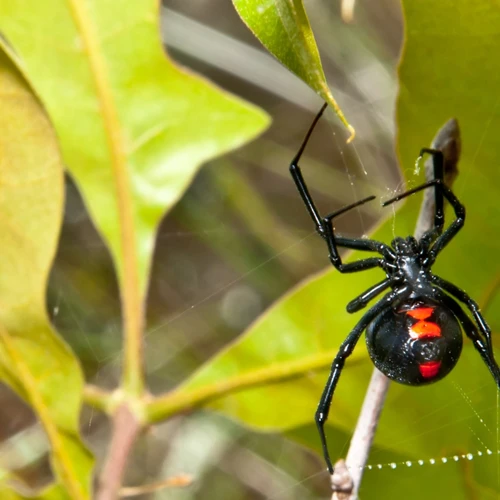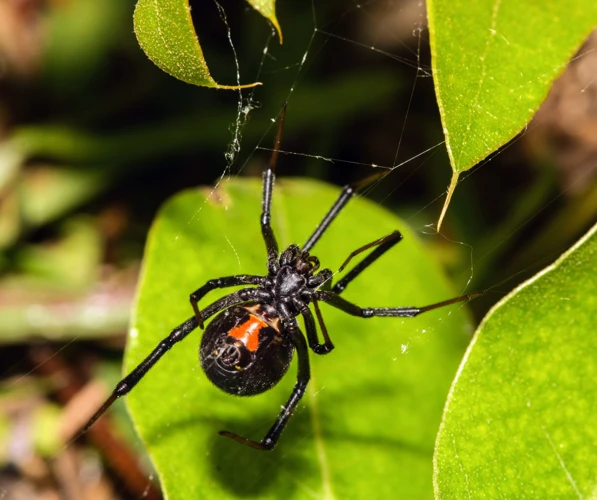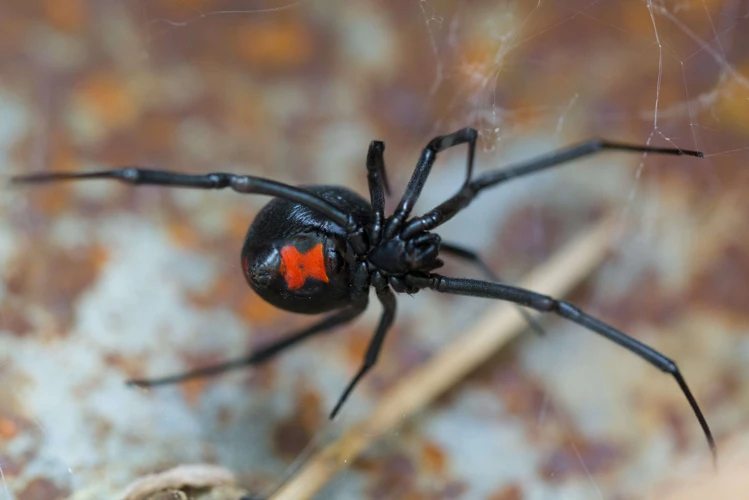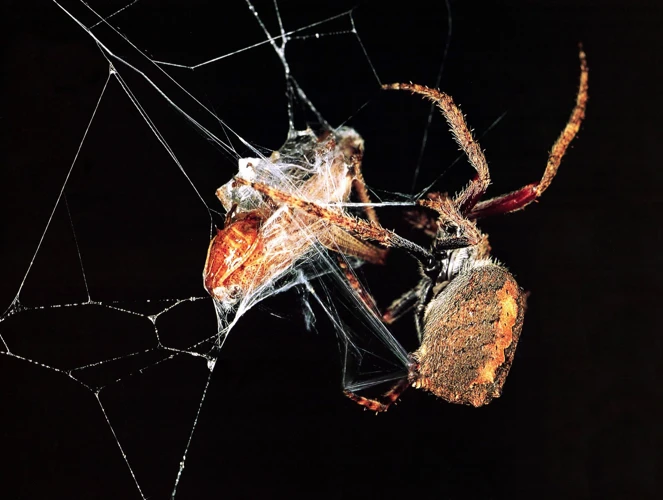The enigmatic relationship between black widow spider populations and natural disasters such as forest fires, floods, and tornadoes has always piqued the curiosity of many. Despite their notorious reputation, black widow spiders are fascinating creatures that have adapted to survive in various conditions. In this article, we delve into the physical description, habitat, and diet of black widow spiders. We explore the impact of forest fires, floods, and tornadoes on black widow spider populations. With this information, we hope to gain a better understanding of these creatures and their complex interactions with the environment.
What are Black Widow Spiders?

Black Widow Spiders are some of the most well-known arachnids in the world, renowned for their venomous bites and distinctive markings. These spiders belong to the genus Latrodectus and are mainly found in warm regions around the world. While there are over 30 species of Latrodectus spiders, the most commonly recognized species in North America is the Southern Black Widow (Latrodectus mactans). In this section, we will delve into the physical characteristics and habitat of these fascinating spiders, as well as their diet preferences.
Physical Description of Black Widow Spiders
Black Widow Spiders are highly venomous spiders and are known for their distinctive appearance. These spiders have a shiny black body with a bright red or orange hourglass marking on the abdomen, which serves as a warning sign that the spider should be avoided. The females are generally larger than the males, with an average size of about 1.5 inches in length including their legs.
Black Widow Spiders also have a unique web-building style. They build irregular, tangled webs that are designed to trap their prey. They typically hang upside down in their webs, waiting for their prey to come close enough to be trapped.
It is important to be able to identify Black Widow Spiders in order to avoid contact with them. The distinctive hourglass marking on the abdomen is the most recognizable feature of the Black Widow Spider. Another way to identify them is by their cobweb-style webs which they build in dark corners of buildings, basements, and other secluded areas.
While there are many types of spiders, the physical appearance of Black Widow Spiders makes them stand out, and their venomous bite makes them a dangerous threat to humans and other animals who come into contact with them. In fact, black widows are considered amongst the most dangerous spiders in North America.
Knowing how to identify these spiders and their distinctive web-building style can help you stay safe and avoid contact with the Black Widow Spiders. To learn more about the identification and distribution of black widows, check out this article on identifying black widow spiders.
Habitat and Diet of Black Widow Spiders
Black widow spiders are widely recognized for their distinctive, glossy black bodies and bright red hourglass-shaped markings on their abdomens. These spiders prefer warm, dry environments and are found throughout much of North America, from the southern United States to Canada. Black widow spiders are known for their distinctive webs that are built close to the ground in secluded locations, such as under rocks, in tree stumps, and in dense vegetation.
The diet of black widow spiders consists primarily of insects, such as flies and mosquitoes, and other spiders. Once prey becomes ensnared in their webs, black widow spiders use their venomous bites to immobilize and kill their victims. This venom is highly toxic and primarily used for subduing their prey, but it can also be dangerous to humans. Adult black widow spiders can go weeks between meals, and they are able to survive for months without food if necessary. This ability to sustain themselves during periods of food scarcity can increase their lifespan, making them a more persistent presence in their environment.
Black widow spiders are remarkably well-adapted to survive in a wide variety of habitats, including deserts, forests, and even in human-built structures. They can also be found in some unusual habitats, such as in anthills or in the water under docks. These spiders can produce multiple egg sacs during their lifespan, and they tend to reproduce more frequently in areas where their food sources are plentiful.
In recent years, there have been concerns about the potential impact that invasive black widow spiders could have on ecosystems. This underscores the need for ongoing research on black widow spider populations, their distribution, and the factors that influence their survival and reproduction. To learn more about black widow spiders and their habitat, check out the prevalence of black widow spiders in North America article.
Forest Fires and Black Widow Spider Populations

Forest Fires are one of the most devastating natural disasters that can ravage through a forest. The effects of forest fires can be seen in the barren landscapes that they leave behind. However, the extent of their impact goes beyond just the destruction of the forest. The aftermath of forest fires can influence the population and habitat of several creatures residing in the forest, including the black widow spiders. These spiders are infamous for their venomous bite, and their population may have a direct or indirect relation to the occurrence of forest fires. Let’s delve deeper into the effects of forest fires on black widow spider populations and their habitat.
Direct Effects of Forest Fires
Forest fires have a significant direct impact on black widow spider populations. These direct effects include:
- Death: Black widow spiders can be killed directly during a forest fire. The intense heat can cause their bodies to dry out and dehydrate or they can be burned alive in the flames.
- Displacement: The fire can force black widow spiders out of their habitat and into new areas where they may not be able to find suitable food or shelter.
- Injury: Some spiders may survive a fire, but they may suffer injuries during the process. These injuries can make it difficult to hunt for prey and can make them more vulnerable to predators.
- Decrease in prey populations: Forest fires can also impact the prey populations of black widow spiders. Prey animals like insects and smaller arachnids may be killed or forced to flee their habitats due to the fires. This leads to a decrease in the food sources for black widow spiders.
It’s important to note that the direct impact of forest fires on black widow spider populations can vary depending on the severity of the fire and the proximity of the spiders to the fire’s epicenter. Despite these direct impacts, black widow spiders are able to adapt to their environments and overcome these challenges over time.
However, it’s also important to consider the indirect effects that forest fires can have on black widow spider populations. These effects can include changes in the overall ecosystem due to tree loss or shifts in plant populations. These ecosystem changes can then impact the black widow’s prey, leading to changes in the spider’s habitat and food supply.
This connection between forest fires and black widow spider populations highlights the importance of understanding the complex relationships between different species in ecosystems. It’s crucial for researchers and communities to continue studying and monitoring the impact of natural disasters on vulnerable species like black widow spiders.
Indirect Effects of Forest Fires
Forest fires have several indirect effects on black widow spider populations. The first is the reduction in vegetation cover and biomass, leading to a decreased availability of prey. This can ultimately impact the spiders’ survival and reproductive success. Additionally, the destruction of vegetation can remove microhabitats the spiders use for shelter, camouflaging, and egg-laying. The loss of these microhabitats can further reduce the suitability of the environment for black widow spiders.
Forest fires can cause changes in the physical and chemical properties of soil, including pH, nutrient availability, and water-holding capacity. These changes alter the structure and function of ecosystems, leading to potentially cascading effects on black widow spider populations. For example, changes in soil moisture can influence the distribution and density of vegetation, thereby impacting prey abundance and ultimately spider abundance.
Additionally, forest fires can lead to changes in the composition and density of animal communities, which can indirectly impact black widow spider populations. For instance, post-fire areas can become dominated by non-native or invasive species that outcompete native species. If these invasive species do not provide suitable prey for black widow spiders, their populations could suffer. It’s essential to study the impacts of invasive species on the ecosystem to understand their impact on spider populations better.
Although forest fires have numerous direct and indirect impacts on ecosystems and black widow spider populations, the exact effects depend on various factors like severity, frequency, and spatial scale. Nonetheless, it seems clear that black widow spiders are well-adapted to disturbance environments and can rapidly recolonize burned areas provided suitable microhabitats and prey are available.
Reference link: The Impact of Invasive Species on Ecosystems.
Floods and Black Widow Spider Populations

The Impact of Floods on Black Widow Spider Populations
Natural disasters are known to have a significant impact on the ecosystem, and floods are no exception. Floods can completely disrupt the environment, leaving long-term effects that can affect the survival of various species, including the black widow spider. These arachnids are known for their ability to thrive in a wide range of habitats, but what happens to their populations when floods occur? In this section, we will explore the direct and indirect effects of floods on black widow spider populations. We will also discuss the importance of understanding these effects in the context of the overall health of our ecosystem.
Direct Effects of Floods
Direct Effects of Floods:
Floods have a direct impact on Black Widow Spider populations as they destroy their natural habitats. Black Widow Spiders inhabit dark areas like crevices and holes in rocks, under logs, and leaves. When floods occur, the water levels rise, and these habitats get washed away. This displacement can cause the spiders to migrate to higher ground in search of new habitats.
During a flood, if a Black Widow Spider’s habitat is underwater, the spider’s eggs are likely to get washed away or drown. The spiderlings also face a high risk of getting carried away in the water and may not survive the flood. These extreme weather conditions can lead to a sudden decrease in Black Widow Spider populations in the affected areas.
Table:
To illustrate the direct effects of floods on Black Widow Spider populations, we can divide them into two categories:
| Impact | Description |
|---|---|
| Displacement | Floods destroy the natural habitats of the Black Widow Spider, causing them to migrate in search of new habitats. |
| Egg and Spiderling Mortality | The spider’s eggs and spiderlings are at high risk of getting carried away in the water and may not survive the flood. |
In areas where flooding occurs frequently, Black Widow Spider populations may struggle to recover and may even struggle to maintain their presence. However, many other factors contribute to Black Widow Spider populations, such as human activity and climate change. To learn more about these factors, check out our articles on human activity and Black Widow Spider populations and climate change affecting Black Widow Spider distribution.
Indirect Effects of Floods
Flooding can have both direct and indirect effects on black widow spider populations. Floods can lead to habitat destruction, soil erosion, and changes in vegetation that can have profound impacts on spiders and their prey. Below are some of the indirect effects floods can have on black widow spider populations:
- Changed Habitat: Floods can alter the habitats of black widow spiders by washing away their nests or causing changes in the vegetation and soil. Floods can also lead to soil erosion, which can displace prey species that black widow spiders rely on for food.
- Changes in Prey Populations: Floods can cause population changes among the insects and other small animals that black widows prey on. If their prey is displaced by flooding or their habitats are destroyed, it can lead to a decrease in black widow populations.
- Dispersal and Migration: Spiders have evolved several ways to deal with sudden onset of floods. Extreme floods can trigger mass exoduses of spiders to higher ground. Black widow spiders are not good travelers, so their populations may be disrupted for some time after flooding events.
It is important to note that the effects of flooding on black widow spider populations can vary depending on the severity of the flood, the location of the flooding, and the resilience of the local ecosystem. Nonetheless, the indirect effects of flooding are an important factor to consider when understanding how natural disasters can impact black widow spider populations.
If you’d like to learn more about black widow spider habitats, check out our article on unusual habitats for black widow spiders. If you’re interested in comparing black widow spiders to other dangerous spider species, we recommend our article on comparing dangerous spiders.
Tornadoes and Black Widow Spider Populations
The impact of natural disasters on wildlife populations is a complex topic, and black widow spiders are no exception to this. While forest fires and floods can have a direct and indirect effect on black widow spider populations, tornadoes are a different story. In this section of the article, we will examine how tornadoes affect black widow spider populations, including both direct and indirect effects. Before we dive in, let’s first take a moment to review what we know about these fascinating arachnids. For more information on identifying black widow spiders, you can check out our article on identifying black widow spiders.
Direct Effects of Tornadoes
Tornadoes can have direct effects on black widow spider populations, as these severe storms can destroy habitats and kill spiders directly. During a tornado, high winds can demolish trees, shrubs, and other vegetation that black widow spiders use for shelter. When the spiders lose their homes, they may be swept away by the strong winds or left exposed to predators. Tornadoes can also wreak havoc on buildings and other structures, potentially killing black widows that have made their homes in these areas.
Direct Effects of Tornadoes On Black Widow Spider Populations:
- Tornadoes can destroy spider habitats, leaving them homeless and exposed to predators.
- Tornadoes can cause structural damage, which may kill black widows that have created their webs in these areas.
- High winds during tornadoes can sweep spiders away.
In some cases, tornadoes can actually displace black widow spiders from one area to another, which may impact their populations on a larger scale. After a tornado, spiders that survive may migrate to new areas, which could result in changes to their distribution and density.
Despite these direct effects, it is important to note that tornadoes are not the only factor that can impact black widow spider populations. Habitat loss due to deforestation, climate change, and other human activities can also be a major threat to these spiders across the world. Mapping of black widow populations is still a widely-developing area, and understanding their distribution is crucial to the efforts of conservation scientists.
If you’re interested in finding out more about the global distribution of black widow spiders, check out our related article on global black widow distribution.
Indirect Effects of Tornadoes
Tornadoes have several indirect effects on black widow spider populations that come as a result of the destruction these storms leave behind. Here are some ways that tornadoes may indirectly impact the presence of black widow spiders in a given area:
- Displacement from natural habitats: Tornadoes can uproot entire trees and shrubs, destroy dense vegetation, and leave debris strewn across the land. This can disrupt black widow spider populations, causing them to be displaced from their natural habitats and forcing them to seek food and shelter elsewhere.
- Increased food availability: While tornadoes may displace black widow spiders from their preferred habitats, they can also have the opposite effect by creating favorable hunting conditions. The high winds and rainfall associated with tornadoes can flush out insects and other prey, making them easier for black widow spiders to catch. As a result, these spiders may experience a temporary surge in food availability, which can help them thrive in the aftermath of a storm.
- Changes in prey availability: Tornadoes can disrupt the balance of ecosystems by changing the availability of certain types of prey. For example, a tornado may wipe out an entire population of a species that black widow spiders commonly feed on. This could have a major impact on the spider population if they are unable to find alternative food sources.
Tornadoes can have both positive and negative impacts on black widow spider populations, depending on the specific circumstances surrounding the storm. Nevertheless, it is clear that these natural disasters are an important factor to consider when studying the distribution and ecology of these spiders. If you want to learn more about black widow spider populations around the world, check out our interactive map that highlights their geographic range and other interesting facts.
Conclusion
After exploring the relations between black widow spider populations and natural disasters, it is evident that forest fires, floods, and tornadoes affect these creatures directly and indirectly. Despite the fact that these spiders can adapt to fluctuations in their environment, natural disasters have a significant impact on their populations.
Forest fires result in a decrease in the amount of vegetation, which affects the black widow spider’s prey population. However, there is also evidence that these spiders can benefit from an increase in temperature and humidity caused by forest fires. Floods can wash away their web and disrupt their ability to feed, while tornadoes can physically destroy their habitats.
While the effects of natural disasters on black widow spiders are alarming, it is important to note that these spiders play an important role in their ecosystem as predators of insects. It is also essential to continue researching the relationship between natural disasters and these spiders to better understand their adaptations and to develop measures to protect them.
Overall, the effects of natural disasters on black widow spiders are complex and should not be underestimated. By taking necessary precautions and conducting further research, we can potentially minimize the impact of natural disasters on these spiders and ensure a healthy ecosystem for all.
Frequently Asked Questions
1. Can black widow spiders survive forest fires?
Black widow spiders have adaptations such as their burrowing behavior and ability to regulate moisture that may help them survive forest fires.
2. Do forest fires kill black widow spiders?
Yes, some black widow spiders may not be able to survive intense or prolonged forest fires and can perish as a result.
3. Can black widow spider populations rebound after a forest fire?
If conditions allow, black widow spider populations can rebound after a forest fire, but it may take time for their habitat and prey to recover.
4. Can black widow spiders survive floods?
Black widow spiders can survive floods if they are able to find dry locations or materials to create their webs above the water’s surface.
5. Do floods impact black widow spider populations?
Floods can impact black widow spider populations by destroying their webs and disrupting their habitat, potentially reducing their food supply and survival rates.
6. Can black widow spiders be found in areas affected by tornadoes?
It is possible for black widow spiders to be found in areas affected by tornadoes as they are able to move to undamaged areas or places where debris may provide shelter.
7. Do tornadoes have a significant impact on black widow spider populations?
Tornadoes can have a significant direct impact on black widow spider populations by destroying their habitat and webs, but the long-term effects are difficult to determine.
8. Are there any benefits to having black widow spiders in the ecosystem?
Black widow spiders play a role in controlling insect populations and are a food source for some predators such as birds and lizards.
9. Are black widow spiders venomous to humans?
Yes, black widow spiders can be venomous to humans, with bites potentially causing pain, muscle cramps, and other symptoms.
10. Should people be concerned about encountering black widow spiders in areas affected by natural disasters?
While it is always important to be cautious in areas where black widow spiders are known to be present, encountering them in areas affected by natural disasters is not necessarily more likely than in other areas.






